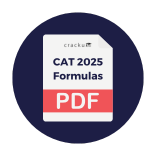The number of whole metallic tiles that can be produced by melting and recasting a circular metallic plate, if each of the tiles has a shape of a right-angled isosceles triangle and the circular plate has a radius equal in length to the longest side of the tile (Assume that the tiles and plate are of uniform thickness, and there is no loss of material in the melting and recasting process) is ...........
Correct Answer: 12
Solution
Let the measure of two equal sides of the right angled isosceles triangle be $$x$$
So, length of hypotenuse (longest side) will be $$\sqrt{\ 2}x$$
This is also equal to radius of the circle
Now, let the tiles and plates have uniform thickness of $$y$$
So, volume of one tile = Surface Area*Thickness = $$\dfrac{1}{2}\times\ x\times\ x\times\ y$$
Similarly, volume of one plate = Surface Area*Thickness = $$\pi\ \left(\sqrt{\ 2}x\right)^2\times\ y=2\pi\ x^2y$$
Let required number of tiles be $$n$$
Now upon melting and recasting volume will remain same as there is no loss of material
So, $$n\cdot\dfrac{1}{2}\cdot x\cdot x\cdot y=2\pi\ x^2y$$
or, $$n=4\pi\ =4\times\ 3.14=12.56$$
Since $$n$$ has to be an integral value, required number of tiles = 12
Create a FREE account and get:
- Download Maths Shortcuts PDF
- Get 300+ previous papers with solutions PDF
- 500+ Online Tests for Free

